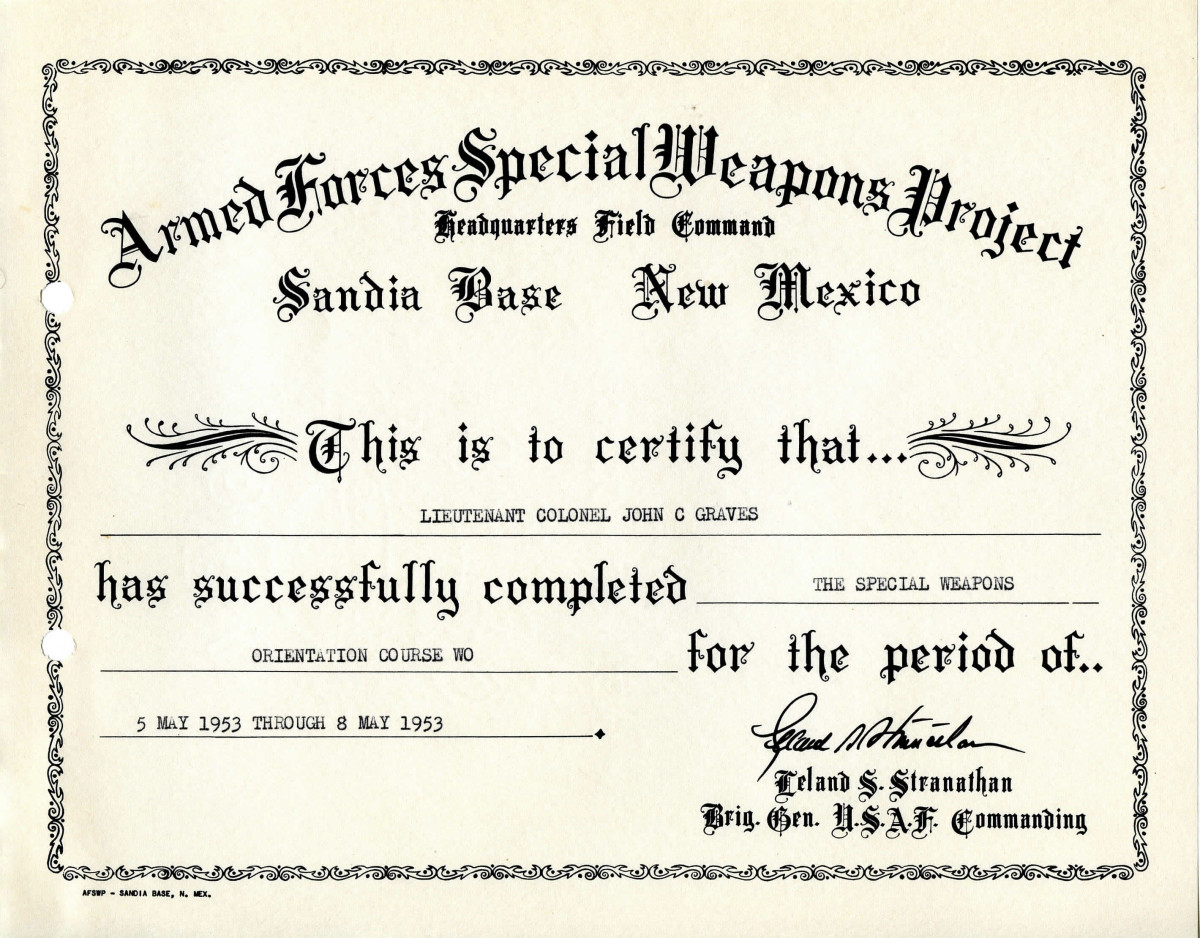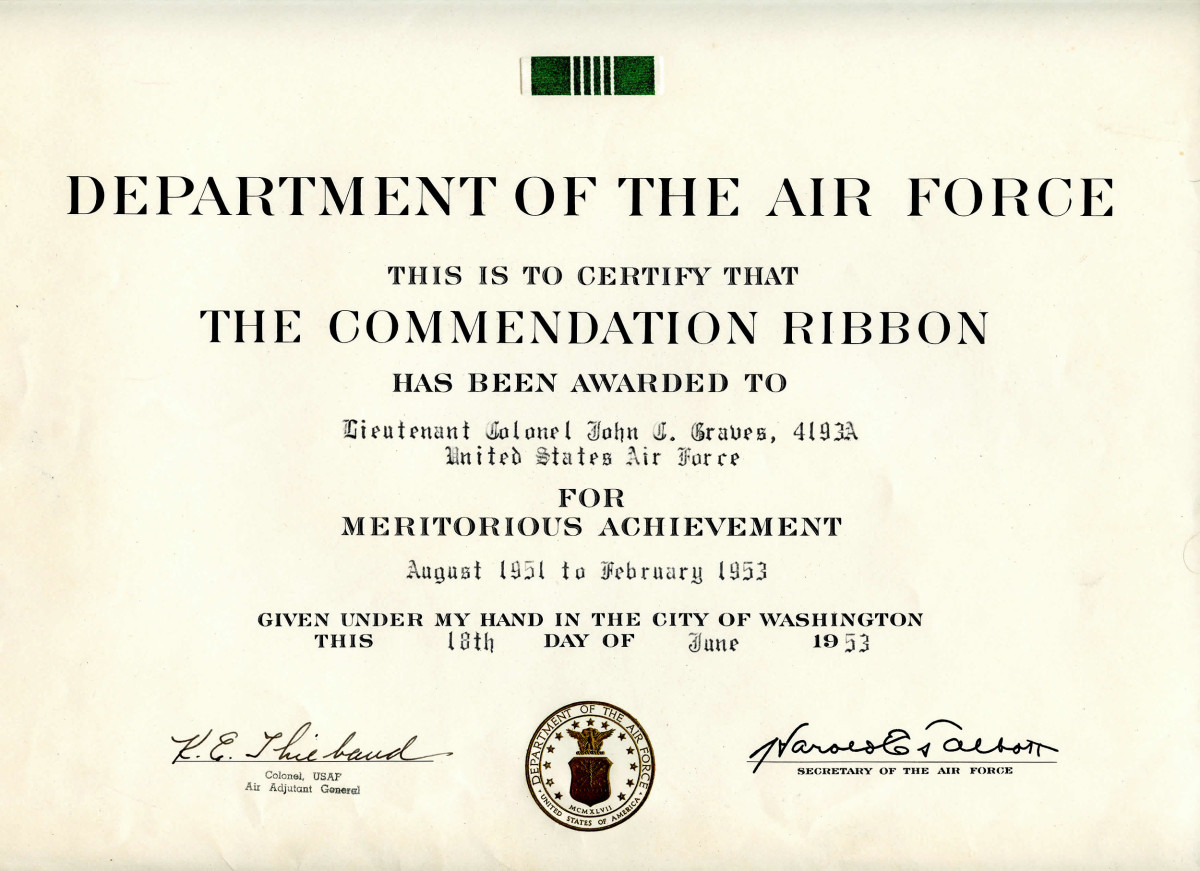Cpt. John C. Graves
Click any picture to enlarge.
.
John C. Graves hailed from Sulphur Springs, New Mexico. After graduating from the University of New Mexico, he enlisted in the U. S. Army Infantry in 1940. In 1942 he earned his pilot wings and rank of 2nd Lt. at Goodfellow Field, basic flying school.
Graves was sent to the ETO and joined the 344th Bomb Group 494th Bomb Squadron based in Stansted, England.
See a complete list of his missions here.
His first flight there was dated March 1, 1944 and his first combat mission was March 6, 1944. It was also the first combat mission for the 344th BG. He flew as Co-Pilot in plane 42-95916 (K9-H) “Piccadilly Willy.” The plane was in box 1, flight 3, position 4. The target was an aerodrome in Bernay St. Martin, France. The crew included; Kolberg, Pilot; Graves, Co-Pilot; Carbonneay, Nav/Bomb; Strassburg, Radio/Gun; Coker, Eng/Gun; Hohrenberg, Tail Gun.
See formation diagram, map, load list and interrogation report for this March 6, 1944 mission here.
.Graves mission on July 6, 1944 targeted a railroad bridge at Domfront and La Chapelle. His plane that day was most likely 42-95874 K9-S “Susanne.” See interrogation, formation and press release.
.On December 12 Cpt. Graves flew a mission to attack a defended area in Hellenthal. His plane that day was, again, most likely 42-95874 K9-S “Susanne. His crew included; Lt. Fester, Co-Pilot; Capt. Rivers, Nav.; 1st Lt. Curmode, Bomb.; S/Sgt Working, Eng/Gun; M/Sgt. Falk, Radio/Gun; S/Sgt. Anderson Tail Gun. See formation, load list, and interrogation report.
.
Cpt. Graves took part in some of the missions from July 24 – 26, 1944, that earned the 344th BG a Presidential Unit Citation shown below.
Mentioned in this Presidential Unit Citation are the two missions Graves flew on July 25, 1944. Click the links to see load lists, formation for Maintenon mission, press release for each mission and pilot interrogation reports.
July 25, 1944 St. Lo : His crew included 1st Lt. Engelbrecht, Co-Pilot; Capt. Rivers, Nav.; 1st Lt. Curmode, Bomb.; S/Sgt Coker, Eng/Gun; T/Sgt. Strassburg, Radio/Gun; S/Sgt. Nehrenberg Tail Gun. His plane that day was most likely 42-95890 K9-A “Mary Sue III.”
July 25, 1944 Maintenon: His crew included 1st Lt. Engelbrecht, Co-Pilot; Capt. Rivers, Nav.; 1st Lt. Curmode, Bomb.; Capt. Ringstron, Observer; S/Sgt Coker, Eng/Gun; T/Sgt. Strassburg, Radio/Gun; S/Sgt. Nehrenberg Tail Gun. Again, his plane that day was most likely 42-95890 K9-A “Mary Sue III.”
.Perhaps the highlight of Captain Graves tour with the 344th was the mission during which he earned the Distinguished Flying Cross.
To quote the citation, “On August 9, 1944, Captain Graves was leading the high flight in the first box in an attack against enemy boats in the harbor of Brest. Approaching the target, accurate heavy flak was encountered. During the bombing run, the right engine of Captain Graves airplane was hit and the RPM dropped to less than 1500. By skillful handling of his airplane, captain Graves continued his bombing run. Flak damage prevented the release of the bombs and Captain Graves turned off the target. By losing altitude rapidly he was able to keep his airspeed high enough so that he could keep his flight intact while taking evasive action away from the target. As soon as he was clear of the flak Captain Graves called his deputy leader and told him to take over the flight. By this time, the propeller of the right engine had been feathered and Captain Graves proceeded out to sea where he was able, after several attempts, to salvo his bomb load. Lieutenant Smith, copilot, had been wounded by flak on the bombing run and he was now giving himself first aid. Captain Graves trimmed up his airplane and set course for the United Kingdom. However, when he went to check his directional Gyro he found that his magnetic compass had been knocked out by the flak. Working closely with his navigator in determining a correct heading, he brought the damaged airplane and wounded co-pilot safely across 150 miles of water and to an emergency airfield in the United Kingdom. His job was made more difficult by the fact that it was nearly dark when he reach the airfield.” For these actions he was Awarded the Distinguished Flying Cross.
Read the complete Graves DFC recommendation and extract here.
Click the link for the Group Narrative, Target Map, Press Release, and Graves’ Interrogation Report.
Captain Graves also earned 11 Air Medals
After the war Graves was trained on the handling of nuclear weapons, and piloted a nuclear bomber.
The Armed Forces Special Weapons Project responsibilities included the maintenance, storage, surveillance, security and handling of nuclear weapons, as well as supporting nuclear testing.
The Boeing B-47 Stratojet was a long-range, six-engined, turbojet-powered strategic bomber designed to fly at high subsonic speed and at high altitude to avoid enemy interceptor aircraft. The B-47’s primary mission was as a nuclear bomber capable of striking the Soviet Union.
He resigned regular commission as of Feb. 5th, 1954 after receiving more awards and commendations.





















